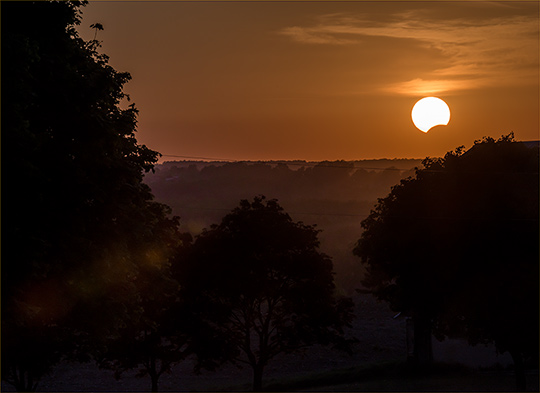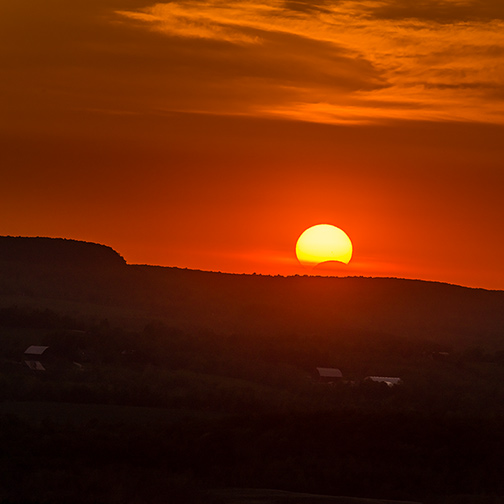Eclipse 2012. Clearview, Ontario. May 20, 2012; 8:32pm EDT
Nikon D800e with Sigma 120-300mm f/2.8 APO
1/3200sec @ f/11. ISO 200. 300mm
On May 20, 2012 there was an annular eclipse of the sun visible over much of Asia and North America. Its line of maximum overlap was in the American southwest, but much of the hemisphere could see it at least partially.
I’m a bit of an eclipse enthusiast. In recent years I’ve traveled toRumania for the 1999 total solar eclipse, and in Death Valley, CA in 2003I organized a workshop around a total lunar eclipse. My interest in eclipses is partially because I’m an astronomy buff. But, I also see them as opportunities to photograph the sun, moon and landscape in rare combination. Shooting a technically perfect image of the earth casting its shadow on the moon, or the moon blocking the sun doesn’t really interest me. What does get my juices going is using these relatively rare events to show the landscape and nature in a novel way.
Close to Home
For personal reasons travel wasn’t in the cards for me for the May 20, 2012 eclipse. I had just come off two weeks of teaching and travel, and the holiday long weekend was a time for relaxation and family. But, during the few days prior I scouted the area near my country place in Clearview County, Ontario for an appropriate vantage point. A bit of research showed that eastern Canada was at the extreme edge of the eclipse path, and we would only see a small corner of the sun eclipsed just before sunset. Not much further east and the sun would already have set before the moon’s edge touched it.
This turned out to be agood news, bad newssituation. Occurring here as it did, just minutes prior to sunset, it meant that the sun would be blocked by the thickest part of the atmosphere and therefore it would be possible to shoot directly into it without (too much) fear of eye or sensor damage. Also, occurring low on the horizon meant that I would be able to include something of the local landscape. The real problems would be the brief period of time between the beginning of visibility and sunset, and also of course the weather.
Scouting and Calculating
I had found what I thought was a decent location not far from my place, on a hilltop in a farmer’s field. Just a hundred meters away, in fact. The view was of an abandoned farm house with hills behind it. I had a mental image of the shot I wanted, with the partially eclipsed sun just to one side. And being so close to home, I could do it with a glass of wine in my hand.
But on the day I got out my iPad withThe Photographer’s EphemerisandRedshift, and quickly saw that my elevation wouldn’t be high enough. The sun would pass beside the farm house and sink below the tree line before first contact.
I regard these two programs as a must for nature and landscape photographers. They allow you to accurately forecast the exact position of the sun and moon on any day, at any time, anywhere in the world – in advance.
I know the local area pretty well, and so during the afternoon I went to the highest hilltop in the area (about a 10 minute drive away), and saw that there would be a clear view toward where the sun would set. But, there was no foreground interest, just an earth-bare farmer’s field. Continuing down the hill toward the west I came across a grove of trees and a farm house. Perfect.
Weather
Weather is one of the things that one can’t really plan or control. As it turned out the weekend was hot and sunny, unusually so for the month of May in Ontario, with high temperatures over 30C (88F).
Equipment and Technique
I used the new Nikon D800e along with my longest lens, the Sigma 120-300mm f/2.8 OS APO. A Really Right Stuff TVC-34L tripod with ARCA SWISS C-Cube head was also used.
Because I would be shooting almost directly into the sun I was very concerned about both highlight fringing around the sun’s edge, and also flare. The Sigma 120-300mm f/2.8 has become a favourite long lens in part because it is an apochromatic design (not totally, but not just marketing hype either), which means minimal fringing. As it turned out, only a small amount of correction in Lightroom 4 was needed. And, as can be seen in the first shot above there inevitably was some flare, but it was well controlled, and even helps the composition.
A Second Chance
Blue Mountain Eclipse. Clearview, Ontario. May 20, 2012; 8:39pm EDT
Nikon D800e with Sigma 120-300mm f/2.8 APO
1/800sec @ f/16. ISO 200. 300mm
As soon as the sun dropped below the trees and horizon I jumped in the car and headed back up the hill, about 100 meters higher elevation. Quickly setting up the tripod I was able to captureBlue Mountain Eclipse, above, before the sun disappeared for the day.
This turned out to be the more successful of the two attempts. The first one,Eclipse 2012, is marred by a power line which I saw while shooting, but couldn’t do anything about. I’d missed it during the scouting trip earlier in the day.
Opening the Shadows
Given the huge exposure challenge of shooting directly into the sun I was inclined to try to use HDR. Indeed I did shoot of a series of 7 exposure bursts, but they just didn’t look natural. In the end I used Lightroom 4’sShadowscontrol to open up the foreground and theHighlightscontrol to tame the sun. These new controls in Process 2012 of Lightroom are nothing short of phenomenal. Also, the Nikon D800’s sensor has remarkable dynamic range, and extracting detail from the deep shadows is beyond anything that I’ve previously seen. Together they made Blue Mountain Eclipsepossible .
May, 2012
You May Also Enjoy...
Photokina 2008
23 September, 2008Photokina opens today with a number of exciting new product announcements. I will not be attending this year because of a timing conflict
Sequencing: Part I
Sequencing. The bane of the would-be book creator. This is the first of two pieces on sequencing, in which I pull together ideas from all over,



